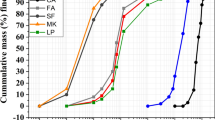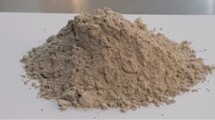Abstract
Purpose
In this study, fresh, mechanical, microstructural, and thermal properties as well as environmental impact of self-compacting mortars (SCMs) were determined by using glassPET (GP) and fly ash (FA). For this work, firstly, control mixture in which 80% of Portland cement (PC) and 20% of FA was designed. Then, GP was used in the ratios of 3%, 6%, and 9% instead of FA.
Methods
During production, the mini-slump flow diameter and the mini-v funnel flow times of the SCMs were measured. After that, the mechanical properties of these mixes were determined via the compressive, flexural, and ultrasonic pulse velocity (UPV) tests at 28 and 90 days. In addition, microstructural and thermal properties of SCMs incorporating GP in the ratios of 0% and 9% instead of FA were determined by using SEM/EDX and TGA/DTA analyzes. Moreover, the comparative life-cycle assessment (LCA) has been conducted using LCA software SimaPro® with ReCiPe database. One kg/m3 of mortar was selected as functional unit and a cradle to gate approach was followed for the LCA including material extraction, transport and production, and system boundaries used.
Results and discussion
Results were given from the software underline the estimated environmental performance of mortar production with providing single scores coming from three gauges including Human Health, Ecosystems, and Resources as well as the strength characterctics of SCMs.
Conclusions
The test results indicated that GP and FA used instead of PC improves the environmental performance of SCMs while adversely affecting the fresh, mechanical, and microstructural properties.

















Similar content being viewed by others
Abbreviations
- DTA:
-
Differential thermal analysis
- EDX:
-
Energy-dispersive X-ray spectroscopy
- EFNARC:
-
The European Guidelines for Self-Compacting Concrete
- FA:
-
Fly ash
- GP:
-
GlassPET
- HRWRA:
-
High-range-water-reducing-admixture
- LCA:
-
Life-cycle assessment
- PC:
-
Portland cement
- PET:
-
Polyethylene terephthalate
- SCM:
-
Self-compacting mortar
- SEM:
-
Scanning electron microscopy
- TGA:
-
Thermogravimetric analysis
- UPV:
-
Ultrasonic pulse velocity
- w/b:
-
Water/binder
References
Afshinnia K, Rangaraju PR (2016) Impact of combined use of ground glass powder and crushed glass aggregate on selected properties of Portland cement concrete. Constr Build Mater 117:263–272
Akca AH, Özyurt N (2018a) Effects of re–curing on microstructure of concrete after high temperature exposure. Constr Build Mater 168:431–441
Akca AH, Özyurt N (2018b) Effects of re-curing on residual mechanical properties of concrete after high temperature exposure. Constr Build Mater 159:540–552
Alsubari B, Shafigh P, Jumaat MZ (2016) Utilization of high-volume treated palm oil fuel ash to produce sustainable self-compacting concrete. J Clean Prod 137:982–996
ASTM C 109/C 109M-99 (1999) Standard Test Method for Compressive Strength of Hydraulic Cement Mortar, Annual Books of ASTM standards
ASTM C 618 (2015) Standard specification for coal fly ash and raw or calcined natural pozzolan for use in concrete, Annual Books of ASTM standards
ASTM C 597-16 (2016) Standard Test Method for Pulse Velocity Through Concrete, Annual Books of ASTM standards
ASTM C 348-14 (2017a) Standard Test Method for Flexural Strength of Hydraulic-Cement Mortars, Annual Books of ASTM standards
ASTM C349-14 (2017b) Standard Test Method for Compressive Strength of Hydraulic-Cement Mortars (Using Portions of Prisms Broken in Flexure), Annual Books of ASTM standards.
Anastasiou EK, Liapis A, Papachristoforou M (2017) Life cycle assessment of concrete products for special applications containing eaf slag. Procedia Environ Sci 38:469–476
Arrigoni A, Beckett C, Ciancio D, Dotelli G (2017) Life cycle analysis of environmental impact vs. durability of stabilised rammed earth. Constr Build Mater 142:128–136
Berndt ML (2009) Properties of sustainable concrete containing fly ash, slag and recycled concrete aggregate. Constr Build Mater 23:2606–2613
Blengini GA, Busto M, Fantoni M, Fino D (2012) Eco-efficient waste glass recycling: integrated waste management and green product development through LCA. Waste Manag 32:1000–1008
Chen C, Habert G, Bouzidi Y, Jullien A (2010) Environmental impact of cement production: detail of the different processes and cement plant variability evaluation. J Clean Prod 18:478–485
Chiu CT, Hsu TH, Yang WF (2008) Life cycle assessment on using recycled materials for rehabilitating asphalt pavements. Resour Conserv Recycl 52:545–556
Deschamps J, Simon B, Tagnit-Hamou A, Amor B (2018) Is open-loop recycling the lowest preference in a circular economy? Answering through LCA of glass powder in concrete. J Clean Prod 185:14–22
Dong YH, Ng ST (2014) Comparing the midpoint and endpoint approaches based on ReCiPe - a study of commercial buildings in Hong Kong. Int J Life Cycle Assess 19:1409–1423
EFNARC (2002) Specification and Guidelines for Self-Compacting Concrete. Free pdf copy downloadable from http://www.efnarc.org, pp. 15-16, (22.11.2018)
Finkbeiner M, Inaba A, Tan R, Christiansen K, Klüppel H-J (2006) The new international standards for life cycle assessment: ISO 14040 and ISO 14044. Int J Life Cycle Assess 11(2):80–85
Frigione M (2010) Recycling of PET bottles as fine aggregate in concrete. Waste Manag 30:1101–1106
Ginés O, Chimenos JM, Vizcarro A, Formosa J, Rosell JR (2009) Combined use of MSWI bottom ash and fly ash as aggregate in concrete formulation: environmental and mechanical considerations. J Hazard Mater 169:643–650
Hossain U, Poon CS, Lo IMC, Cheng JCP (2017) Comparative LCA on using waste materials in the cement industry: A Hong Kong case study. Resour Conserv Recycl 120:199-208
Huang Y, Bird R, Heidrich O (2009) Development of a life cycle assessment tool for construction and maintenance of asphalt pavements. J Clean Prod 17:283–296
Khoshnava SM, Rostami R, Ismail M, Rahmat AR (2018) A cradle-to-gate based life cycle impact assessment comparing the KBFwEFB hybrid reinforced poly hydroxybutyrate biocomposite and common petroleum-based composites as building materials. Environ Impact Assess Rev 70:11–21
Macko M (2012) Size Reduction by Grinding as an Important Stage in Recycling. Post-Consumer Waste Recycl Optim Prod 273–294
Maraghechi H, Salwocki S, Rajabipour F (2017) Utilisation of alkali activated glass powder in binary mixtures with Portland cement, slag, fly ash and hydrated lime. Mater Struct Constr 50:1–14
Marceau ML, Nisbet MA, Vangeem MG (2006) Life Cycle Inventory of Portland Cement Manufacture. SN2095b Portland Cement Association Skokie Illinois USA, pp 4-5
Marcelino-Sadaba S, Kinuthia J, Oti J, Seco Meneses A (2017) Challenges in life cycle assessment (LCA) of stabilised clay-based construction materials. Appl Clay Sci 144:121–130
Mateus R, Neiva S, Bragança L, Mendonça P, Macieira M (2013) Sustainability assessment of an ınnovative lightweight building technology for partition walls – comparison with conventional technologies. Build Environ 67:147–159
Meyer C (2009) The greening of the concrete industry. Cem Concr Compos 31:601–605
Miller SA (2018) Supplementary cementitious materials to mitigate greenhouse gas emissions from concrete: can there be too much of a good thing?. J Clean Prod 178:587–598
Monteiro PJM, Miller SA, Horvath A (2017) Towards sustainable concrete. Nat Mater 16:698–699
Moretti L, Mandrone V, D’Andrea A, Caro S (2017) Comparative “from cradle to gate” life cycle assessments of hot mix asphalt (HMA) materials. Sustain 9:1–16
Nath P, Sarker PK, Biswas WK (2018) Effect of fly ash on the service life, carbon footprint and embodied energy of high strength concrete in the marine environment. Energy Build 158:1694–1702
North EJ, Halden RU (2013) Plastics and Environmental Health: The Road Ahead. Rev Environ Health 28:1–8
PRé (2014) Various authors, SimaPro Database Manual, Methods Library, Report version: 2.6, May 2014
Saikia N, de Brito J (2012) Use of plastic waste as aggregate in cement mortar and concrete preparation: a review. Constr Build Mater 34:385–401
Siddique R, Khatib J, Kaur I (2008) Use of recycled plastic in concrete: a review. Waste Manag 28:1835–1852
Singh N, Singh SP (2016) Carbonation resistance and microstructural analysis of low and high volume fly ash self compacting concrete containing recycled concrete aggregates. Constr Build Mater 127:828–842
Song D, Yang J, Chen B, Hayat T, Alsaedi A (2016) Life-cycle environmental impact analysis of a typical cement production chain. Appl Energy 164:916–923
Teixeira ER, Mateus R, Camõesa AF, Bragança L, Branco FG (2016) Comparative environmental life-cycle analysis of concretes using biomass and coal fly ashes as partial cement replacement material. J Clean Prod 112:2221–2230
Valipour M, Yekkalar M, Shekarchi M, Panahi S (2014) Environmental assessment of green concrete containing natural zeolite on the global warming index in marine environments. J Clean Prod 65:418–423
Vitale P, Arena N, Di Gregorio F, Arena U (2017) Life cycle assessment of the end-of-life phase of a residential building. Waste Manag 60:311–321
Whitehurst EA (1951) Soniscope tests concrete structures. J Am Concr Inst 47:443–444
Funding
This research has been supported by Niğde Ömer Halisdemir University Scientific Research Projects Coordination Unit, Project Number FEB2017/21-BAGEP, 2017–2018.
Author information
Authors and Affiliations
Corresponding author
Additional information
Responsible editor: Holger Wallbaum
Publisher’s Note
Springer Nature remains neutral with regard to jurisdictional claims in published maps and institutional affiliations.
Electronic supplementary material
ESM 1
(DOC 53 kb)
Rights and permissions
About this article
Cite this article
Demirel, S., Öz, H.Ö., Güneş, M. et al. Life-cycle assessment (LCA) aspects and strength characteristics of self-compacting mortars (SCMs) incorporating fly ash and waste glass PET. Int J Life Cycle Assess 24, 1139–1153 (2019). https://doi.org/10.1007/s11367-018-1562-5
Received:
Accepted:
Published:
Issue Date:
DOI: https://doi.org/10.1007/s11367-018-1562-5




